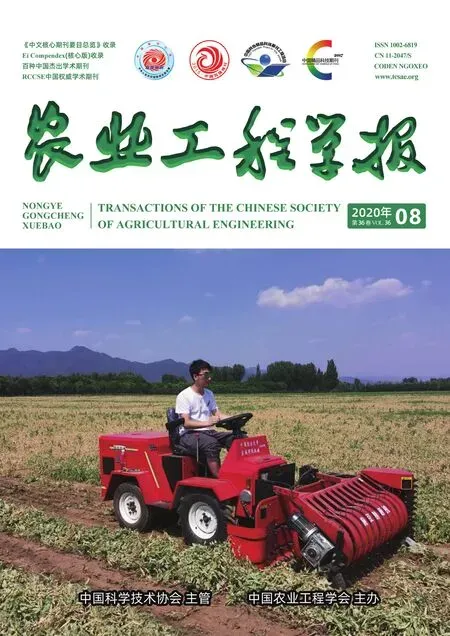正戊醇-柴油混合燃料发动机颗粒物的形貌结构与氧化活性研究
汪 映,王 鹏,王小琛
正戊醇-柴油混合燃料发动机颗粒物的形貌结构与氧化活性研究
汪 映,王 鹏,王小琛
(西安交通大学能源与动力工程学院,西安 710049)
掺混正戊醇能够降低柴油机颗粒物排放,但掺混正戊醇对柴油混合燃料颗粒物的形貌结构和氧化活性的影响规律尚不明确。该研究采用高分辨率透射电子显微镜、拉曼光谱仪和同步热分析仪研究了柴油机中分别燃用不同掺混比的正戊醇/柴油混合燃料时生成颗粒物的形貌、纳观结构和氧化活性。结果表明,正戊醇掺混体积比分别为0、15%和30%的3种混合燃料燃烧颗粒物的微观形貌相似,低倍率时表现为由基本碳粒子聚合而成的团聚形貌,高倍率时呈现出典型的“外壳-内核”结构;随着正戊醇掺混比例的增加,颗粒物的基本碳粒子直径减小,微晶长度减小而微晶曲率增加,D1峰与G峰的峰面积比增加。说明颗粒物结构更为无序,石墨化程度降低。同时,随着正戊醇掺混比例的增加,3种燃料燃烧颗粒物的氧化温度逐渐降低,依次为:616.9、609.9和583.6 ℃,说明其对应的氧化活性逐渐升高。分析表明,正戊醇/柴油混合燃料燃烧生成的颗粒物高氧化活性与其更为无序的纳观结构相关。
柴油机;正戊醇;颗粒物;纳观结构;氧化活性
0 引 言
大气颗粒污染是目前人类面临的主要环境污染问题之一,而柴油机排气颗粒物是大气颗粒物污染的主要来源之一。研究表明,柴油混合含氧醇类燃料可以有效降低柴油机颗粒物排放[1-3]。正戊醇是一种新型生物质燃料,可以通过纤维素和糖类制取。相较于甲醇、乙醇等低碳醇而言,正戊醇具有较高的低热值、十六烷值和黏度,较低的汽化潜热,且与柴油的互溶性很好,更适用于压燃发动机的燃烧模式[2]。基于此,柴油掺混正戊醇受到越来越多的关注。
Campos-Fernandez等[4-5]的研究表明,尽管正戊醇的低热值较柴油低,但正戊醇含氧的特性使得其燃烧过程更为充分,因此,混合燃料的发动机动力性与燃用柴油时相差不大。Wei等[6]对柴油掺混正戊醇的颗粒物排放进行了试验研究,研究表明,正戊醇的掺混可以降低颗粒物质量浓度和总数量浓度。这是因为,正戊醇本身含氧,且正戊醇的掺混延长了滞燃期,使得缸内混合气工质更为均匀。Huang等[7]的数值模拟研究表明,正戊醇可降低芘(A4,碳烟前驱物),主要就是因为正戊醇十六烷值低、汽化潜热高及分子结构中含C-O键。
近年来,颗粒物的纳观结构、化学组成和氧化活性受到广泛关注。研究柴油机排气颗粒物的纳观结构、化学组成和氧化活性不仅可以加深对于颗粒物生成与演变机理的认识,还能进一步指导柴油颗粒捕捉器(Diesel Particulate Filter,DPF)的设计,具有重要意义[8-9]。Zhang等[10]对柴油/正戊醇混合燃料的化学组成开展了试验研究。结果表明,混合燃料可以明显降低元素碳(Elemental Carbon,EC)排放,略微降低有机碳(Organic Carbon,OC)排放。Zhu等[11]研究表明,随着正戊醇掺混比例的增加,生物柴油颗粒物的基本碳粒子直径减小,且对应碳烟微粒的氧化活性降低。但是,目前关于柴油/正戊醇混合燃料发动机颗粒物的形貌结构和氧化活性的研究报道较少。为此,本文拟采用高分辨率透射电子显微镜、拉曼光谱仪和同步热分析仪对柴油/正戊醇混合燃料发动机颗粒物的形貌结构和氧化活性进行试验研究与参数表征,为深入认识正戊醇掺混对柴油机颗粒物生成特性的影响提供基础理论参考。
1 试验装置与方法
1.1 试验台架及试验燃料
试验发动机为车用高压共轨柴油机,其参数如表1所示。测控系统由GW160型电涡流测功机和Powerlink FC2000控制柜组成。试验工况为2 000 r/min和0.59 MPa。待发动机暖机后,冷却水温和机油温度分别保持在(80±5)和(85±2)℃时开始采样。采样时,由真空泵直接从发动机排气管采样,真空泵流量为30 L/min。采样滤纸为Whatman公司的47 mm石英纤维滤膜,采样前将滤膜放马弗炉中以600 ℃焙烧4 h,以去除水分和杂质。
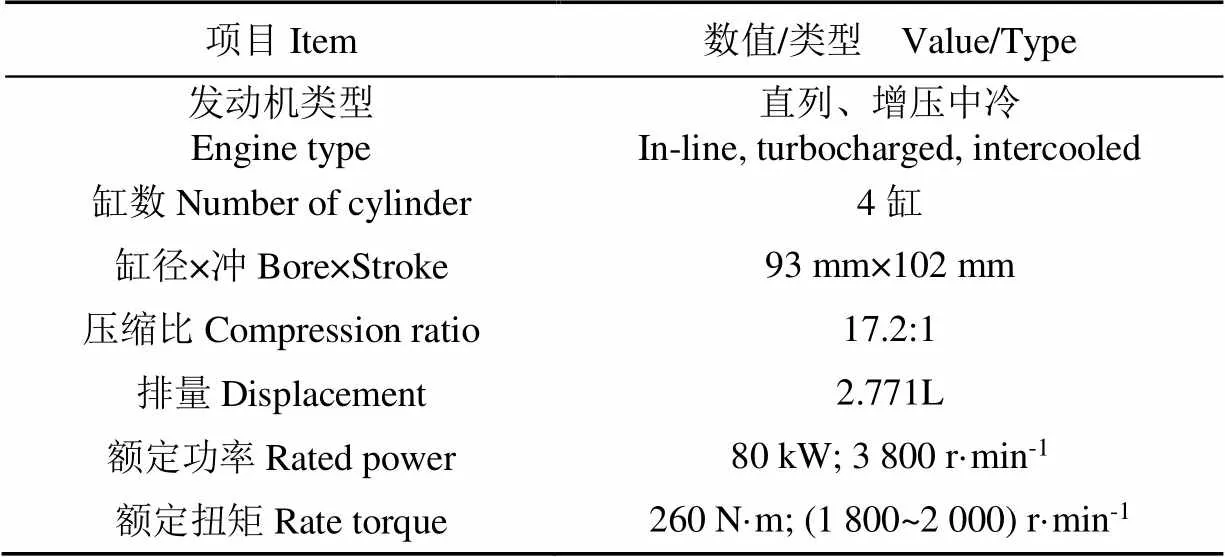
表1 发动机参数
以中石化生产的0#柴油(D100)为对比燃料,在柴油中分别掺混体积比为15%和30%的正戊醇,记为DP15、DP30。试验柴油和正戊醇的物理化学性质如表2所示。试验过程中,仅改变试验燃料,发动机喷油策略和其他控制参数(如Exhaust Gas Recirculation, EGR)未做任何改变。
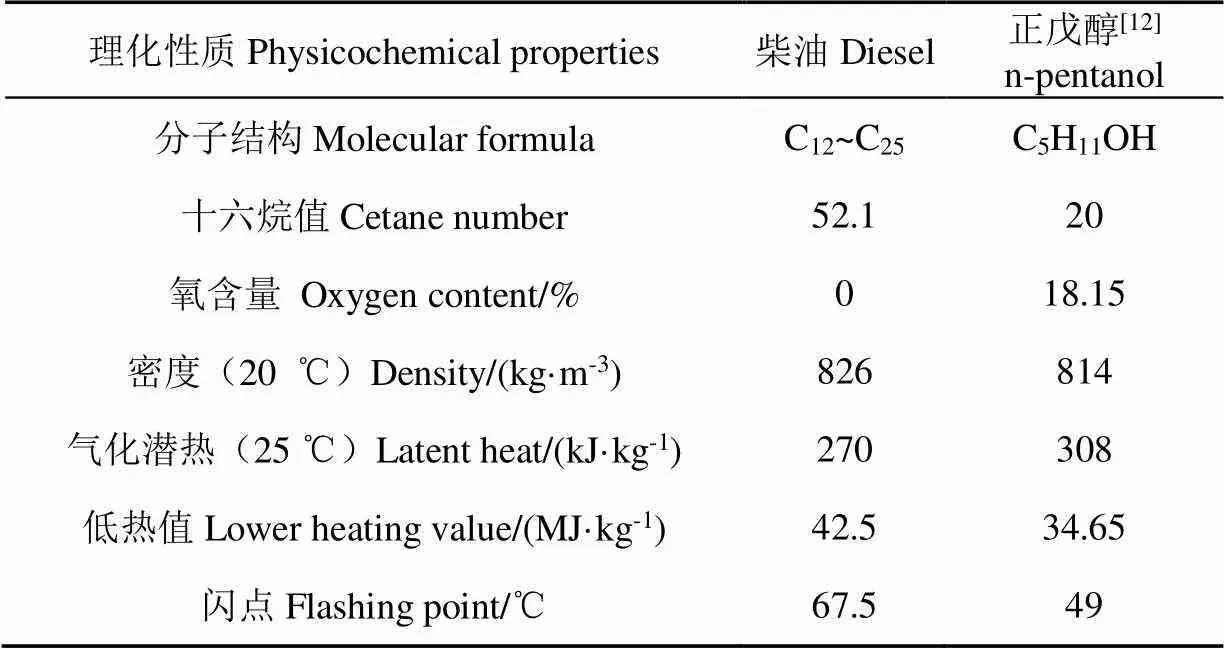
表2 试验柴油和正戊醇的理化特性
1.2 测试方法
采用透射电子显微镜(JEM-2100Plus)观察颗粒物不同放大倍数下的形貌,并结合图片处理软件Image Pro Plus 6.0获得颗粒物结构参数,包括基本碳粒子直径(D)、微晶长度(L)和微晶曲率(T)。参数表征具体方法见论文[13],统计中将长度小于0.483 nm的微晶忽略不计[14]。
采用拉曼光谱仪(LabRAM HR Evaluation)分析颗粒物样品的石墨化程度。选择波长为532 nm的He-Ne激光源,激光功率为3.2 mW,物镜为50倍,扫描时间为30 s。采用4L1G的方法对拉曼光谱进行分峰拟合,其中G峰和D1峰分别位于1 580和1 360 cm-1附近,5个峰分别代表石墨晶体的特定结构特征,详见论文[15]。
利用同步热分析仪(STA 449F5 Jupiter)研究颗粒物的氧化活性。测试从室温以10 ℃/min的速率升温至800 ℃,反应气氛围为空气,流量为100 L/min。选取DSC曲线中最大放热率对应温度为氧化温度,对柴油颗粒物样品进行3次重复试验,该仪器测量氧化温度的重复性误差为±1.05 ℃。
2 试验结果及分析
2.1 颗粒物的微观结构
图1给出了不同燃料排气颗粒物的形貌图。如图1所示,低倍率(40 000×)下,不同燃料排气颗粒物的整体微观形貌差别不大,均呈现出由大量近似球状的基本碳粒子团聚而成的簇状结构。
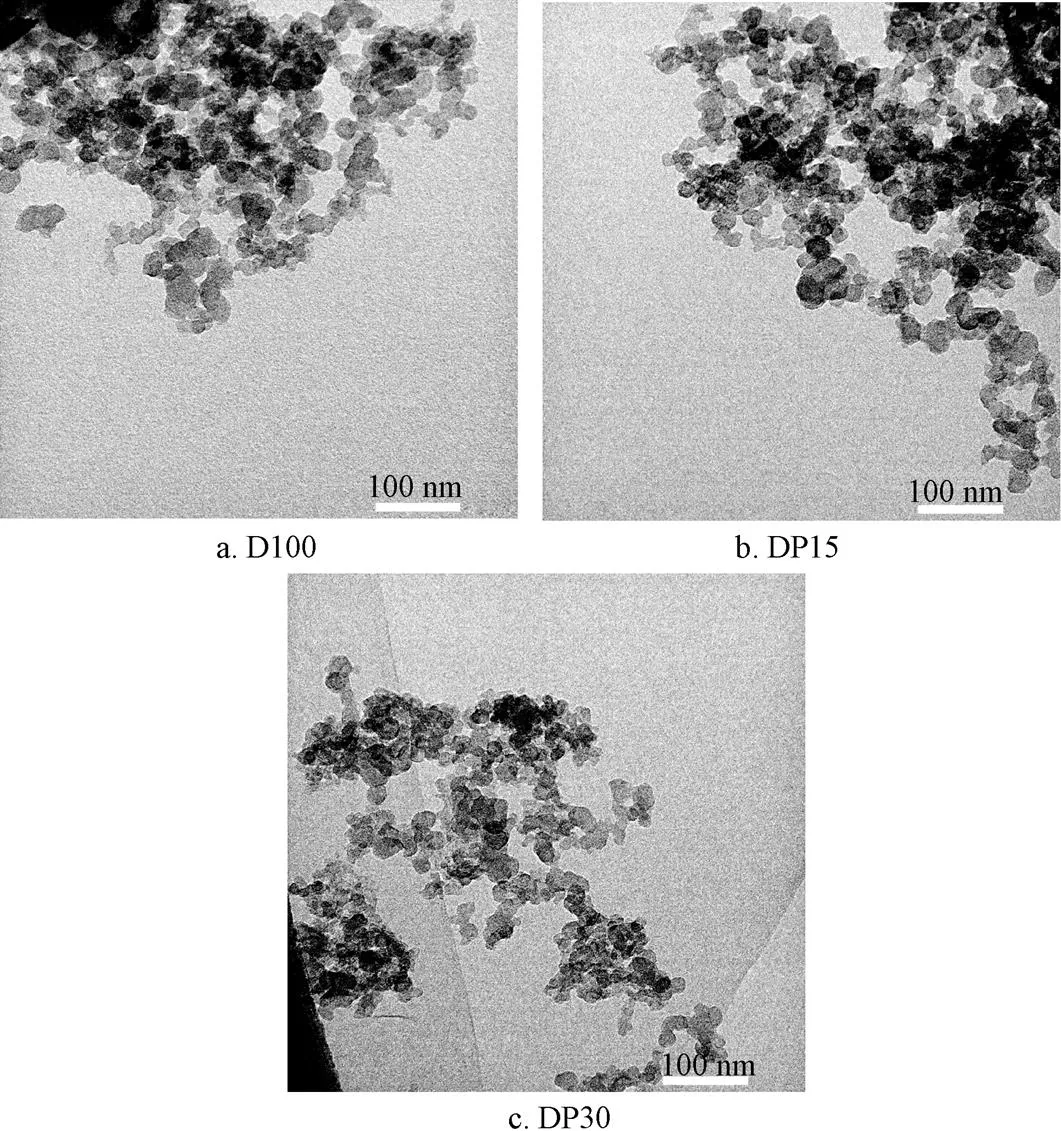
注:D100、DP15和DP30分别为0#柴油,掺混体积比为15%和30%的正戊醇,下同。
图2给出了燃用不同燃料时颗粒物的基本碳粒子直径统计结果。图中箱体上下端分别代表统计数据的75%位数和25%位数,箱体中横线表示统计数据的中间值,箱体中实心点表示平均数,箱体延伸出的长度代表统计数据的标准方差。
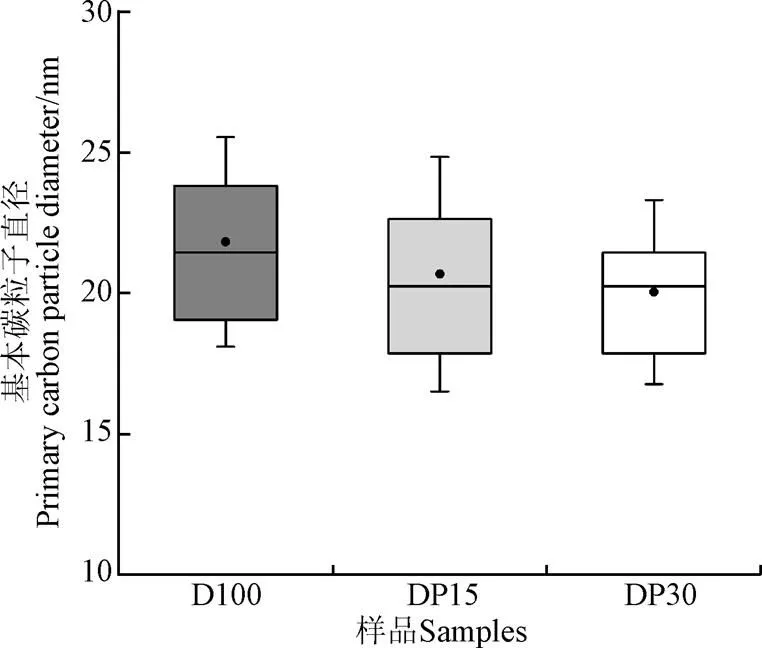
图2 不同燃料燃烧颗粒物的基本碳粒子直径
由图2可知,基本碳粒子的平均直径随正戊醇掺混比例增加而下降(从21.813下降至20.030)。分析认为,基本碳粒子的平均直径主要受碳烟生成过程中表面生长和氧化所决定[9]。由于正戊醇含氧,促进了碳烟的氧化过程;与此同时,正戊醇的掺混减少了碳烟前驱物如芘的生成[7],进而减少了碳烟的表面生长。因此,柴油掺混正戊醇后,颗粒物的基本碳粒子平均直径降低。
2.2 颗粒物的纳观结构
高倍率(800 000×)透射电子显微镜下,燃用不同燃料时颗粒物的基本碳粒子均呈现出典型的“外壳-内核”结构,如图3所示。图中,用短线条勾勒出基本碳粒子的“外壳”轮廓及微晶分布,用圆圈标识出“内核”位置。具体而言,“外壳”部分主要表现为相互平行的微晶,代表着基本碳粒子的有序性;“内核”部分则表现为不规则分布的微晶,代表着基本碳粒子的无序性。由图3可知,燃用不同燃料时颗粒物的基本碳粒子均存在部分石墨化和部分无序性。在高分辨率下,同样可以看出燃用纯柴油时的基本碳粒子直径大于燃用混合燃料时的基本碳粒子直径。对比可知,燃用纯柴油时,“外壳”的微晶层状分布较为明显,且与“内核”不定型结构间界限清晰。但随着正戊醇掺混比的增大,基本碳粒子纳观结构的壳核界限逐渐模糊,微晶分布更趋于无序化。
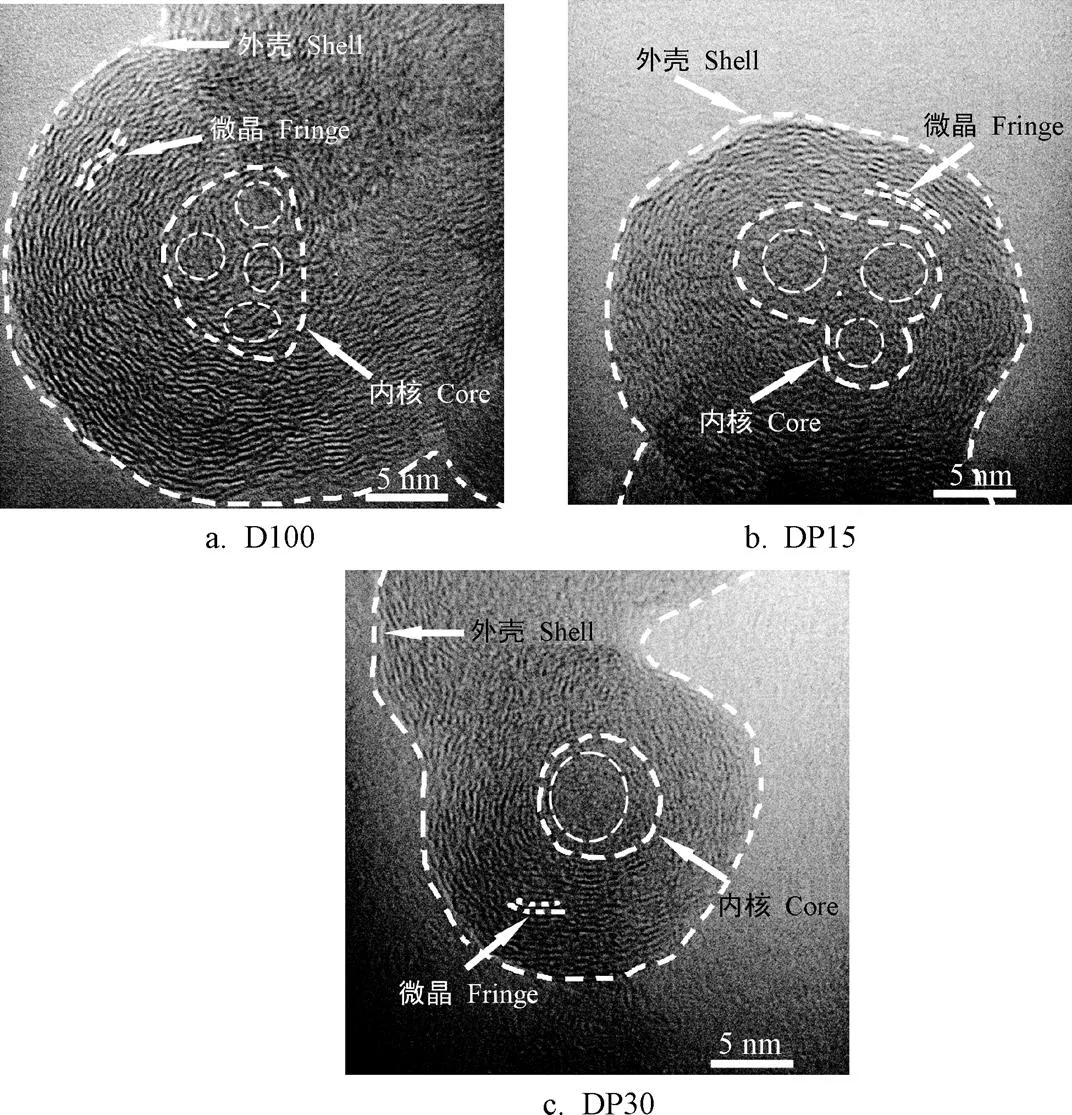
图3 不同燃料燃烧颗粒物的基本碳粒子纳观形貌
图4给出了燃用不同燃料时颗粒物的微晶长度图4a和微晶曲率图4b的统计结果。由图4可知,随着正戊醇掺混比例的增加,基本碳粒子的微晶长度减小而微晶曲率增加。具体地,当正戊醇掺混比例为15%和30%时,微晶平均长度分别减小了0.025和0.051 nm。颗粒物基本碳粒子微晶长度的减少,说明微晶中位于碳层内部的碳原子减少而位于碳层边缘的碳原子增多[16]。同时,当正戊醇掺混比例为15%和30%时,基本碳粒子的微晶曲率平均值分别增加了2.35%和2.73%。与微晶长度类似,微晶曲率的增加,表明微晶中位于碳层内部的碳原子缺失程度增加[17]。
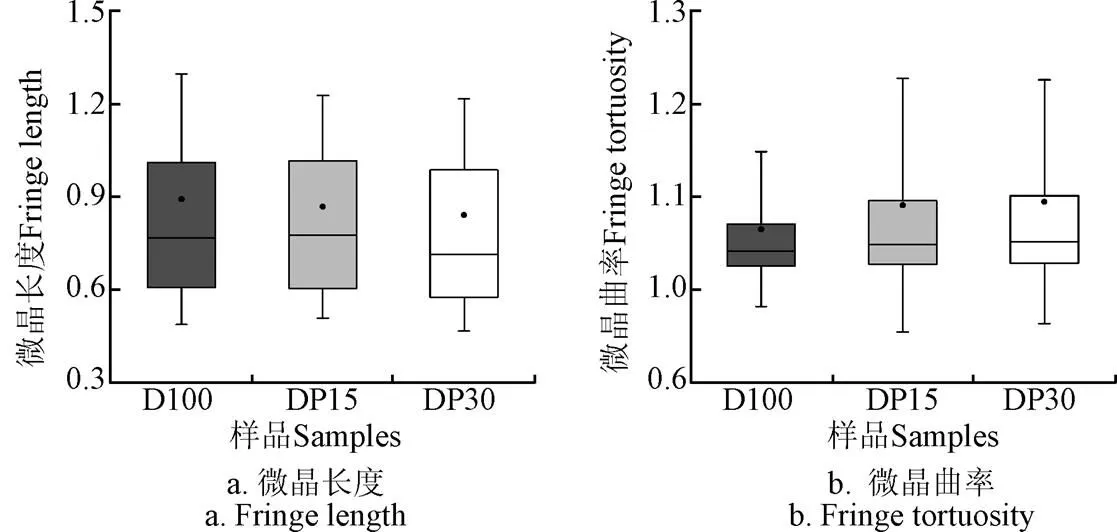
图4 不同燃料燃烧颗粒物的纳观结构参数
综合以上纳观结构参数的分析结果,发现柴油掺混正戊醇后,颗粒物基本碳粒子的微晶长度减少,伴随着微晶曲率增加,表明颗粒物的纳观结构更加无序,且无序化程度随正戊醇掺混比例的增加而增加。类似地,Lapuerta等[18]也发现,柴油掺混正丁醇后,颗粒物基本碳粒子的微晶长度减少而曲率增加。分析认为,由于正戊醇的十六烷值较柴油低且蒸发潜热较柴油大,导致混合燃料的着火滞燃期延长且扩散燃烧持续时间缩短[5]。一方面,较长的着火滞燃期为燃料和空气提供更长的混合时间,同时结合其含氧特性的作用改善了缸内局部富油区;另一方面,混合燃料的扩散燃烧持续期缩短减少了颗粒物生成的持续时间。两方面因素降低了颗粒物的生成和碳化速率,使得颗粒物的微观结构更趋于无序化分布。
2.3 颗粒物的石墨化程度
图5分别给出了不同燃料燃烧颗粒物的一阶拉曼光谱及其分峰拟合曲线。
由图5可知,3种燃料的原始一阶光谱曲线趋势一致。本文采用分峰后A1/A的比值,表征排气颗粒物的石墨化程度[19],如图6所示。A1与A分别源于石墨层活性位点和有序石墨碳,因此A1/A代表石墨碳层的有序化程度。
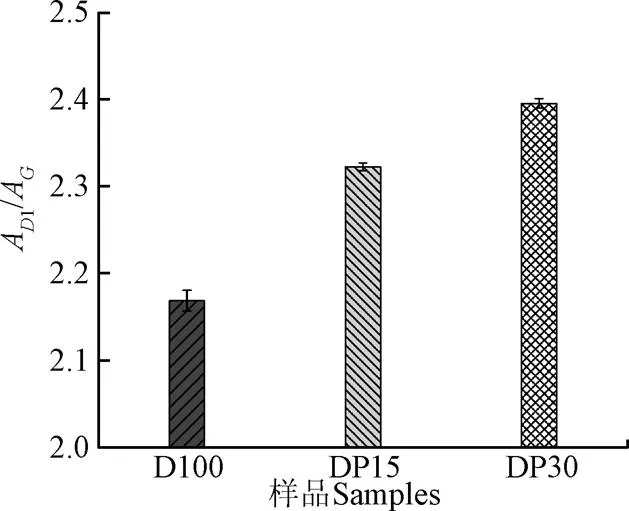
注:AD1和AG分别表示图5中拉曼分峰曲线D1和G与直线y=0围成的面积,下同。
由图6可知,柴油燃烧颗粒物的A1/A最小,即微粒中位于活性位点的碳原子比例最小,说明柴油碳烟微粒更趋于石墨化。这与HRTEM结果中,柴油碳烟微粒的纳观结构更趋于有序化分布一致。反之,DP30颗粒物的A1/A最大,对应结构更趋于无序。正如2.2小节中所述,掺混正戊醇后燃烧颗粒物的结构更趋于无序,这主要归因于正戊醇掺混后对混合燃料中多环芳香烃的稀释效应和正戊醇含氧特性对颗粒物生成过程的影响。
2.4 颗粒物的氧化活性
图7给出了颗粒物质量损失随温度升高的变化曲线。由图7可以看出,D100、DP15和DP30 3种样品在150 ℃之前几乎都没有质量下降;而在200~300和450~600 ℃之间有2个很明显的失质量区,分别对应挥发性有机成分的氧化与挥发,以及碳烟的氧化;当所有样品超过650 ℃时,质量基本不再变化。由图7还可知,D100和DP15的挥发性有机成分差别不大,而DP30的挥发性有机成分明显较前二者多。
为表征颗粒物的氧化活性,图8给出了不同燃料燃烧颗粒物的氧化温度。由图8可知,随着正戊醇掺混比例的增加,D100、DP15和DP30颗粒物的氧化温度逐渐降低,依次为:616.9、609.9和583.6 ℃,对应的氧化活性逐渐升高。
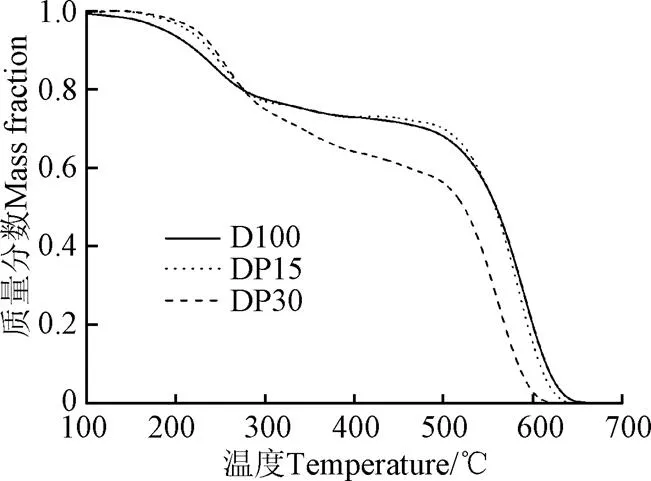
图7 不同燃料燃烧颗粒物的热重曲线

图8 不同燃料燃烧颗粒物的氧化温度
大量研究表明,颗粒物的氧化活性取决于颗粒物的纳观结构、化学组成等性质[13,17,20]。图9给出了D100、DP15和DP30 3种颗粒物样品氧化活性与形貌、纳观结构之间的关系。由图9 a可知,随着掺混比例增加,基本碳粒子直径减小,氧化温度降低,对应氧化活性升高。由图9 b可知,随着掺混比例增加,微晶长度减小且微晶曲率升高,即基本碳粒子纳观结构无序化程度增加,对应氧化温度降低,氧化活性升高。分析认为,微晶长度减小,即小尺寸碳层增加,增加了碳层边缘碳原子数量;由于位于碳层边缘的碳原子的活性较碳层内部的碳原子活性高[21],因而增加了颗粒物的氧化活性。同时,混合燃料微晶曲率的增加也表明碳层内奇数环增多且sp2/sp3杂化率增加,而奇数环和sp3杂化碳原子结构的增加则表示该结构氧化活性增加[22]。图9 c也表明,随着正戊醇掺混比例的增加,A1/A比逐渐升高,对应颗粒物石墨化程度降低,氧化活性升高。

图9 颗粒物氧化温度与形貌结构的相关性
3 结 论
本文在车用高压共轨柴油机上,研究了正戊醇掺混比对柴油机燃烧微粒氧化活性与微观形貌结构的影响,得到以下结论:
1)随着正戊醇掺混比例的增加,混合燃料燃烧生成的颗粒物的基本碳粒子直径减小,微晶长度减小但微晶曲率增加,这表明颗粒物的纳观结构更趋于无序。
2)通过拉曼光谱分析得出,随着正戊醇掺混比的增加,混合燃料燃烧颗粒物A1/A增加,表明颗粒物的石墨化程度降低
3)随着正戊醇掺混比例的增加,混合燃料燃烧颗粒物的氧化温度降低,对应氧化活性增加。这与其更为无序的纳观结构相关。因此燃用柴油/正戊醇混合燃料可以影响柴油机DPF的再生性能,且燃用混合燃料时,DPF需要的再生温度降低。
[1] Celebi Y, Aydin H. An overview on the light alcohol fuels in diesel engines[J]. Fuel, 2019, 236: 890-911.
[2] Kumar B R, Saravanan S. Use of higher alcohol biofuels in diesel engines: A review[J]. Renew. Sust. Energ. Rev, 2016, 60: 84-115.
[3] Krmar S, Cho J H, Park J, et al. Advances in diesel-alcohol blends and their effects on the performance and emissions of diesel engines[J]. Renew. Sust. Energ. Rev, 2013, 22: 46-72.
[4] Campos-Fernandz J, Arnal J M, Gomez J, et al. A comparison of performance of higher alcohols/diesel fuel blends in a diesel engine[J]. Appl. Energ., 2012, 95: 267-275.
[5] Campos-Fernandz J, Arnal J M, Gomez J, et al. Performance tests of a diesel engine fueled with pentanol/diesel fuel blends[J]. Fuel, 2013, 107: 866-872.
[6] Wei L, Cheung C S, Huang Z. Effect of n-pentanol addition on the combustion, performance and emission characteristics of a direct-injection diesel engine[J]. Energy, 2014, 70: 172-180.
[7] Huang H, Lv D, Zhu J, et al. Development and validation of a new reduced diesel/n-pentanol mechanism for diesel engine applications[J]. Energy Fuels, 2018, 32(9): 9934-9948.
[8] Wang X, Wang Y, Bai Y, et al. An overview of physical and chemical features of diesel exhaust particles[J]. Journal of the Energy Institute, 2019, 92: 1864-1888.
[9] Li Z, Song C, Song J, et al. Evolution of the nanostructure, fractal dimension and size of in-cylinder soot during diesel combustion process[J]. Combust Flame, 2011, 158(8): 1624-1630.
[10] Zhang Z H, Chua S M, Balasubramanian R. Comparative evaluation of the effect of butanol–diesel and pentanol–diesel blends on carbonaceous particulate composition and particle number emissions from a diesel engine[J]. Fuel, 2016, 176: 40-47.
[11] Zhu L, Xiao Y, Cheung C S, et al. Combustion, gaseous and particulate emission of a diesel engine fueled with n-pentanol (C5 alcohol) blended with waste cooking oil biodiesel[J]. Appl. Therm. Eng., 2016, 102: 73-79.
[12] Wei L, Cheung C S, Huang Z. Effect of n-pentanol addition on the combustion, performance and emission characteristics of a direct-injection diesel engine[J]. Energy 2014, 70: 172-180.
[13] Wang X, Wang Y, Bai Y, et al. Effects of 2,5-dimethylfuran addition on morphology, nanostructure and oxidation reactivity of diesel exhaust particles[J]. Fuel, 2019, 253: 731-740.
[14] Botero M L, Chen D, Gonzalez-calera S, et al. HRTEM evaluation of soot particles produced by the non-premixed combustion of liquid fuels[J]. Carbon, 2016, 96: 459-473.
[15] Sadezky A, Muckenhuber H, Grothe H, et al. Raman microspectroscopy of soot and related carbonaceous materials: Spectral analysis and structural information[J]. Carbon, 2005, 43: 1731-1742.
[16] Vander Wal R L, Tomasek A J. Soot nanostructure: dependence upon synthesis conditions[J]. Combust Flame, 2004, 136(1/2): 129-140.
[17] 郝斌. 不同燃料对柴油机排气颗粒物的影响研究[D]. 天津:天津大学,2014.
Hao Bin. Effect of Fuel Identity on the Exhaust Particles from Diesel Engine[D]. Tianjin: Tianjin University, 2014. (in Chinese with English abstract)
[18] Lapuerta M, Sanchez-valdepenas J, Barba J, et al. Analysis of soot from the use of butanol blends in a Euro 6 diesel engine[J]. Energy Fuels, 2019, 33(3): 2265-2277.
[19] Zhu J, Lee K O, Yozgatligil A, et al. Effects of engine operating conditions on morphology, microstructure, and fractal geometry of light-duty diesel engine particulates[J]. Proceedings of the Combustion Institute, 2005, 30(2): 2781-2789.
[20] Muhlbauer W, Zollner C, Lehmann S, et al. Correlations between physicochemical properties of emitted diesel particulate matter and its reactivity[J]. Combust Flame, 2016, 167: 39-51.
[21] Singh M, Vander Wal R L. Nanostructure quantification of carbon blacks[J]. Journal of Carbon Research, 2019, 5(1): 2.
[22] Vander Wal R L. Initial investigation of effects of fuel oxygenation on nanostructure of soot from a direct-injection diesel engine[J]. Energy Fuels, 2006, 20(6): 2364-2369.
Morphology and oxidation reactivity of exhaust particles from diesel engine fueled by N-pentanol-diesel blend
Wang Ying, Wang Peng, Wang Xiaochen
(,710049,)
The exhaust particles from diesel engine can be reduced by mixing diesel with n-pentanol, however, the effect of n-pentanol blending fuels on the oxidation reactivity and morphology of diesel exhaust particulates has not been well understood. Therefore, this paper aims to design an experiment and then solve this problem. Experiments were conducted in a high pressure common-rail diesel engine, and three fuels were selected, including pure diesel, DP15 (15% n-pentanol +85% diesel, by vol.), and DP30 (30% n-pentanol +70% diesel, by vol.). In this work, the engine speed and torque were set at 2000 r/min and 0.59MPa, respectively. Tests were performed without any engine modification, but only with fuels change. In the test, the particulate samples were collected from the exhaust pipe of the engine through a vacuum pump, then the particulate matter (PM) characteristics were analyzed by transmission electron microscope (TEM), Raman spectroscopy (RS) and thermogravimetric analysis (TGA). Results showed that the morphologies of soot particles from three fuels were similar. Soot aggregates with numbers of primary particles were observed at low magnification, while a typical “shell-core” nanostructure was presented at high magnification. The “shell” part is mainly composed of parallel microcrystals, representing the order of basic carbon particles, while the “core” part consists of irregular microcrystals, indicating the disorder of basic carbon particles. With the increase in n-pentanol blending ratio, the oxidation process of soot was promoted due to the oxygen content of n-pentanol, while the mixing of n-pentanol reduced the generation of soot precursor, such as pyrene, and thereby the surface growth of soot decreases. Therefore, the primary particle diameters of soot samples slightly decreased from 21.813 nm to 20.030 nm. Meanwhile, as the n-pentanol blending ratio increased, the fringe length of soot samples decreased 0.025 and 0.051 nm, while the fringe tortuosity increased slightly. The decrease of fringe length and the increase of fringe tortuosity indicated that the nanostructure of particles was much more disordered. Results from TEM images demonstrated that there was less graphitic structure in soot samples emitted from blended fuels. Similar to the results obtained from TEM, a higher AD1/AGwas also observed for blended fuels than others. Since the AD1/AGis an important parameter to characterize the graphitization degree of exhaust particles, the graphitization degree of particles is higher when the value ofA1/Ais smaller. Therefore, the soot samples from diesel/n-pentanol mixtures showed smaller primary particles in size, and more disorder nanostructure. Meanwhile, the oxidation temperature of the particulate samples (616.9 ℃ in pure diesel, 609.9 ℃ in DP15, and 583.6 ℃ in DP30) decreased with the increase of n-pentanol ratio. There was much higher oxidation reactivity in the exhaust particles from blended fuels than others. The correlation analysis between the oxidation activity and morphology showed that the high oxidation activity of particulate samples in the mixed fuel was related to the disordered nanostructure. Finally, the oxidation activity and diesel fuel increased in the exhaust particles that formed by the mixtures of n-pentanol. This finding demonstrates that the blended fuels in the engine can be used to improve the regeneration performance of DPF, and further reduce the required regeneration temperature.
diesel engine; n-pentanol; particulates; nanostructure; oxidation reactivity
汪映,王鹏,王小琛. 正戊醇-柴油混合燃料发动机颗粒物的形貌结构与氧化活性研究[J]. 农业工程学报,2020,36(8):48-53.doi:10.11975/j.issn.1002-6819.2020.08.006 http://www.tcsae.org
Wang Ying, Wang Peng, Wang Xiaochen. Morphology and oxidation reactivity of exhaust particles from diesel engine fueled by N-pentanol-diesel blend[J]. Transactions of the Chinese Society of Agricultural Engineering (Transactions of the CSAE), 2020, 36(8): 48-53. (in Chinese with English abstract) doi:10.11975/j.issn.1002-6819.2020.08.006 http://www.tcsae.org
2019-12-12
2020-03-05
国家自然科学基金资助项目(51776162);陕西省自然科学基础研究计划(2020JM-044)
汪映,教授,主要从事内燃机清洁燃烧与排放控制研究。Email:yingw@mail.xjtu.edu.cn
10.11975/j.issn.1002-6819.2020.08.006
TK464
A
1002-6819(2020)-08-0048-06

